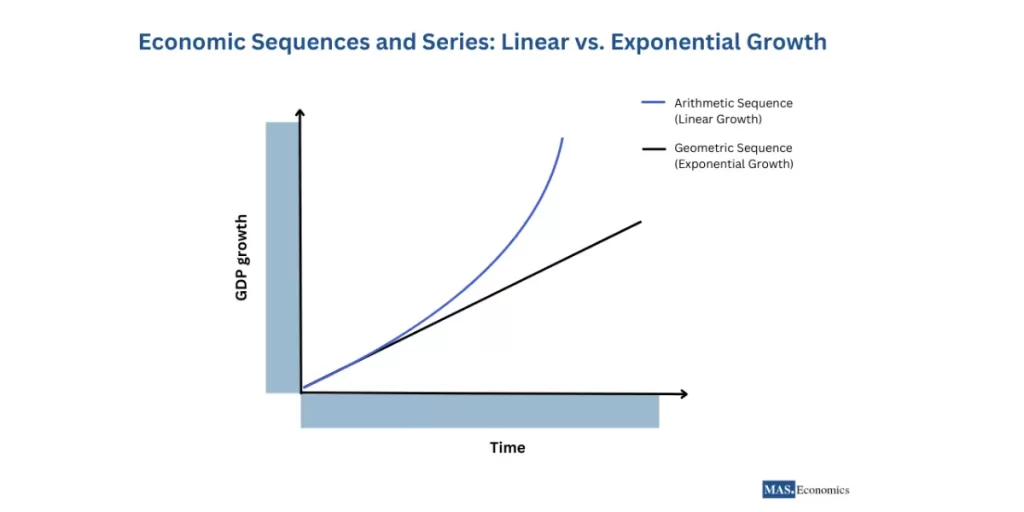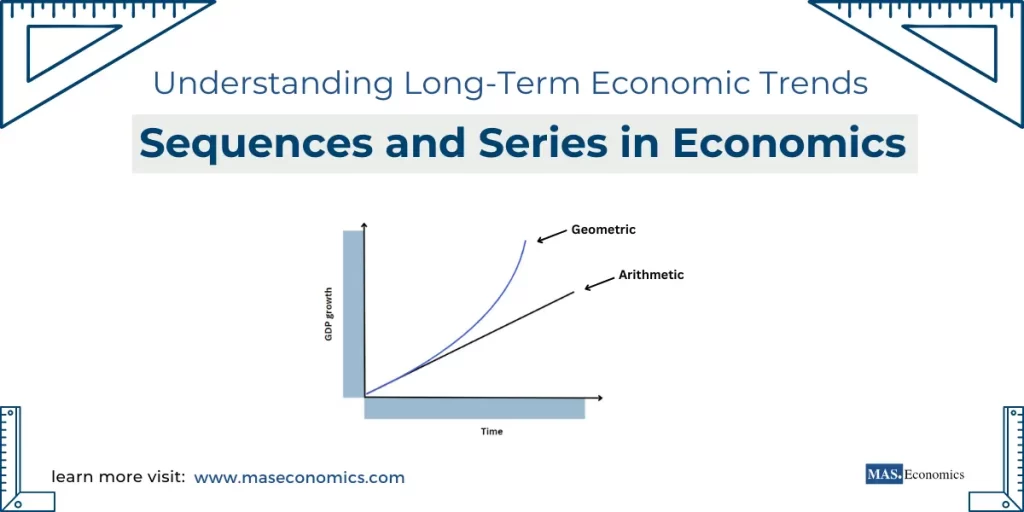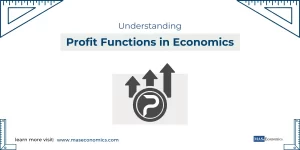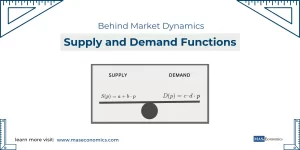In economics, understanding how variables change over time is essential for making informed decisions. Many economic phenomena, such as economic growth, depreciation, or financial annuities, can be studied effectively using sequences and series. These mathematical tools help economists forecast future trends and analyze the long-term impact of different factors, whether it be national GDP growth, investment returns, or the amortization of loans.
What Are Sequences and Series?
Sequences are ordered lists of numbers that follow a particular rule. These numbers are arranged in a way that establishes a clear relationship between the terms. In economics, sequences often represent observations over time, such as annual GDP or quarterly profits.
A series is the sum of the elements of a sequence. Summing the terms in a sequence can help us understand the cumulative effect of a series of economic events. Whether it is calculating the total income earned from an investment or the accumulated depreciation of an asset, series allows us to quantify the overall effect of repetitive economic activities.
Arithmetic Sequences and Series in Economics
Understanding Arithmetic Sequences
An arithmetic sequence is a sequence of numbers in which the difference between any two consecutive terms is constant. This constant difference is known as the common difference \((d)\). Arithmetic sequences are useful for understanding linear growth or decline, which is often observed in economics when analyzing salaries, rents, or resource consumption over time.
The general form of an arithmetic sequence can be represented as:
In which:
- \(A_n\) represents the \(n^{th}\) term in the sequence.
- \(A_1\) is the first term.
- \(d\) is the common difference.
- \(n\) represents the position of the term.
Practical Example: Tracking Depreciation
In economics, depreciation is often calculated using arithmetic sequences. For example, if an asset depreciates by a fixed amount every year, the value of that asset over time can be represented as an arithmetic sequence.
Consider an asset initially valued at $10,000 that depreciates by $1,000 annually. The sequence represents the asset’s value over time is:
10,000, 9,000, 8,000, 7,000, …
In this case, \(A_1 = 10,000\) and \(d = -1,000\). The value of the asset after \(n\) years can be calculated using the arithmetic sequence formula.
Summing an Arithmetic Series
To calculate the total depreciation over a specific period, we use an arithmetic series, which is the sum of terms in an arithmetic sequence. The formula for the sum of the first \(n\) terms of an arithmetic sequence is:
\(S_n = \frac{n}{2} \left( 2A_1 + (n – 1) d \right)\)
Here:
- \(S_n\) represents the sum of the first \(n\) terms.
- \(A_1\) is the first term.
- \(d\) is the common difference.
This formula is helpful in understanding cumulative economic impacts, such as calculating the total depreciation of an asset over several years.
Geometric Sequences and Series in Economics
Understanding Geometric Sequences
A geometric sequence is a sequence of numbers in which each term after the first is obtained by multiplying the previous term by a constant factor called the common ratio \((r)\). Geometric sequences are frequently used in economics to model exponential growth or decay, such as investment returns, population growth, or inflation.
The general form of a geometric sequence can be represented as:
\(G_n = G_1 \cdot r^{(n – 1)}\)
In which:
- \(G_n\) represents the \(n^{th}\) term in the sequence.
- \(G_1\) is the first term.
- \(r\) is the common ratio.
- \(n\) represents the position of the term.
Practical Example: Modeling Economic Growth
Consider a country experiencing a steady annual GDP growth rate of 5%. If the current GDP is $1 trillion, we can model the GDP over the next several years as a geometric sequence with \(G_1 = 1 \, \text{trillion}\) and \(r = 1.05\).
The GDP after \(n\) years can be calculated as:
\(G_n = 1 \times 1.05^{(n – 1)}\)
This approach allows policymakers and economists to predict future economic performance based on historical growth trends.
Summing a Geometric Series
In addition to modeling individual terms, we can also sum a geometric sequence to understand the total accumulated growth over time. The formula for the sum of the first \(n\) terms of a geometric sequence is:
\(S_n = G_1 \left(\frac{1 – r^n}{1 – r}\right), \quad \text{for} \; r \neq 1\)
In this case:
- \(S_n\) represents the sum of the first \(n\) terms.
- \(G_1\) is the first term.
- \(r\) is the common ratio.
This formula is particularly useful in finance, such as when calculating the total value of an annuity over time or the cumulative effects of interest.
Applications in Forecasting and Economic Analysis
Forecasting Long-Term Trends
Sequences and series are invaluable tools for forecasting long-term economic trends. By applying arithmetic or geometric models, economists can estimate how variables such as GDP, interest rates, or employment will evolve over time. This information helps governments and businesses make informed decisions regarding policy, investment, and resource allocation.
For example, if we know that a particular sector of the economy is growing at a consistent rate, we can use a geometric sequence to project its future output. This kind of analysis is critical for macroeconomic planning and helps in anticipating the future needs of an economy, such as infrastructure development or workforce training.
Assessing Financial Annuities
A financial annuity is a series of fixed payments made at regular intervals, such as mortgage payments or retirement savings. Geometric series are often used to calculate the present and future values of these annuities. Understanding the cumulative value of these payments allows individuals and businesses to evaluate investment opportunities and financial obligations.
For instance, the present value of an annuity can be calculated using the formula for the sum of a geometric series, providing insight into how much should be invested today to receive a specific series of payments in the future.
Calculating Depreciation Over Time
Depreciation, particularly straight-line depreciation, is an application of arithmetic sequences in economics. It helps determine how the value of an asset decreases over its useful life. By representing each year’s depreciation as a term in an arithmetic sequence, the cumulative depreciation can be found using an arithmetic series.
This information is crucial for businesses to manage their assets, balance their books, and make decisions about future investments. It also has implications for tax planning, as depreciation can affect taxable income.
Visualizing Economic Sequences and Series
Visual representations can significantly enhance our understanding of sequences and series in economics. Graphs of arithmetic sequences typically show a linear trend, illustrating steady growth or decline. On the other hand, geometric sequences exhibit exponential curves that show how quickly a value can grow or decay over time, depending on the common ratio.
Consider a scenario where we plot GDP growth over time using a geometric sequence. The resulting curve will show how compounding leads to accelerated growth, especially compared to a linear growth model. Such visualizations are powerful tools for communicating economic trends to stakeholders who may not be familiar with the mathematical details.

Importance of Sequences and Series in Economic Decision-Making
The use of sequences and series in economic analysis provides a structured approach to forecasting and evaluating long-term trends. Understanding whether a trend follows an arithmetic or geometric path helps in selecting the appropriate model for prediction and decision-making.
For example:
Arithmetic models are ideal for understanding situations where changes are consistent, such as fixed annual depreciation.
Geometric models are more appropriate for scenarios involving compounding, such as investment growth or inflation.
By identifying the type of sequence that best describes a particular economic phenomenon, economists can provide more accurate forecasts and recommendations, ensuring better resource allocation and planning.
Conclusion
Sequences and series are powerful mathematical tools that are indispensable in economics for analyzing and predicting long-term trends. Arithmetic sequences help in understanding steady changes, while geometric sequences model exponential growth and decay. Whether forecasting GDP growth, calculating the cumulative effect of depreciation, or evaluating financial annuities, these tools provide valuable insights into the dynamics of economic variables over time.
FAQs:
What are sequences and series, and how are they used in economics?
Sequences are ordered lists of numbers following a particular pattern, often representing data over time, like annual GDP or quarterly profits. A series is the sum of terms in a sequence, allowing economists to quantify cumulative effects, such as total depreciation or investment returns.
What is the difference between arithmetic and geometric sequences?
Arithmetic sequences have a constant difference between consecutive terms, useful for modeling linear trends like depreciation or salary increases. Geometric sequences involve a constant ratio between terms, capturing exponential changes, such as economic growth, investment returns, or inflation.
How are arithmetic sequences applied in economics?
Arithmetic sequences are used to model situations with consistent changes over time, like depreciation. For example, if an asset loses $1,000 annually from an initial value of $10,000, the asset’s value over time forms an arithmetic sequence.
How do geometric sequences model economic growth and compounding?
Geometric sequences represent situations involving exponential growth or decay. For instance, a country’s GDP growing at a steady 5% annually can be modeled with a geometric sequence, providing insights into future economic performance.
What is the importance of summing arithmetic and geometric series in economic analysis?
Summing an arithmetic series provides cumulative results, like the total depreciation of an asset over several years. Summing a geometric series helps in financial calculations, such as determining the present value of annuities or cumulative investment returns over time.
How do sequences and series aid in forecasting economic trends?
Sequences and series allow economists to project future outcomes, such as GDP or employment, based on historical patterns. By modeling economic trends accurately, policymakers can make informed decisions regarding investment, infrastructure, and resource allocation.
What role do geometric series play in financial planning and annuities?
Geometric series are essential in calculating the present and future value of annuities. For example, mortgage payments or retirement savings involve regular payments over time, and geometric series help evaluate how these payments accumulate or deplete.
Thanks for reading! Share this with friends and spread the knowledge if you found it helpful.
Happy learning with MASEconomics




